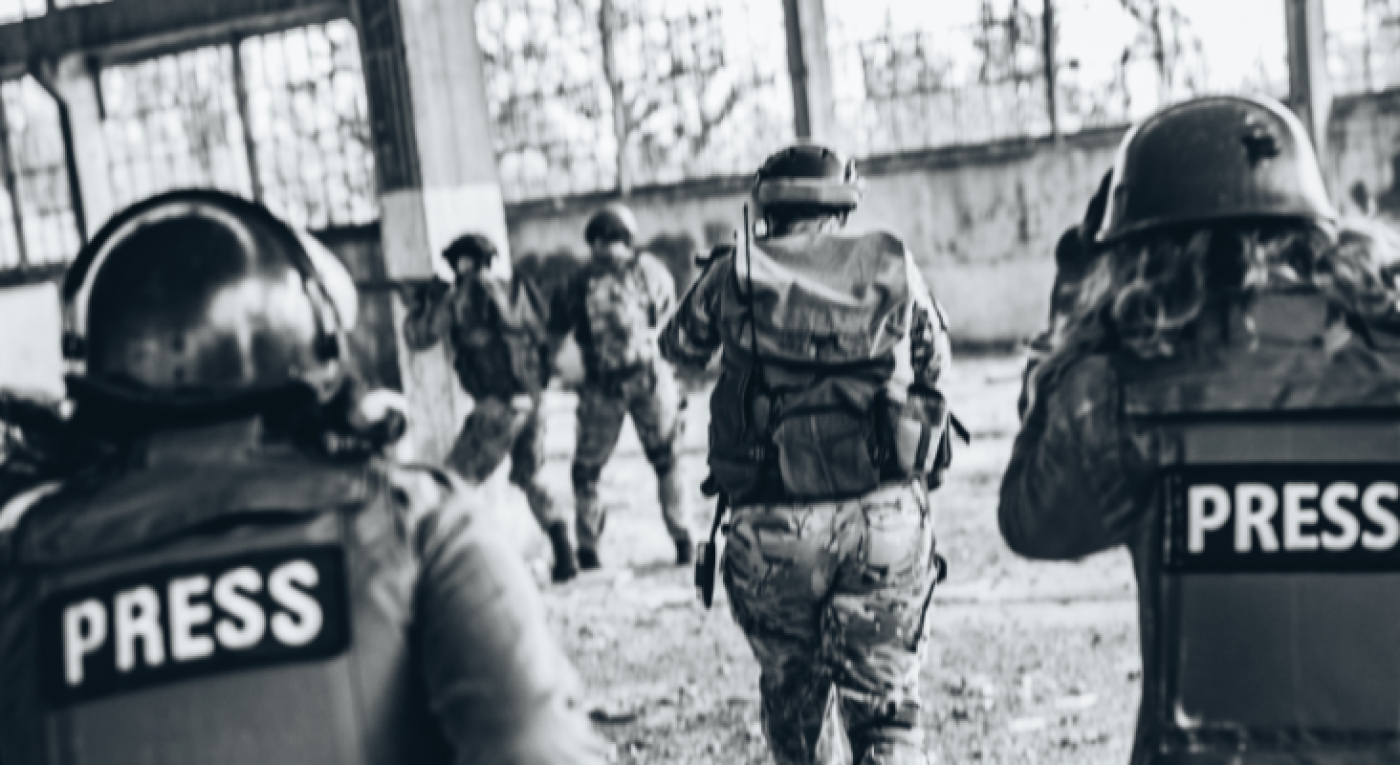Five weeks into this unjust war and the Kremlin’s propaganda machine continues running at full throttle, trying to frame the Russian invasion in a way that will solidify its world power. Despite these efforts, mobile technology in the hands of Ukrainian citizens, Ukrainian military, and de facto reporters from all over the world has unleashed a new paradigm that is both undercutting Putin’s efforts to warp narrative and saving lives in conflict zones, while reshaping the ways the world gets its news.
Stories highlighting the atrocities of this war are emerging from frontlines across Ukraine: in the rubble, up on building tops, from deep underground, and under enemy fire. Handheld footage of farmers hauling away Russian tanks with their tractors have provided uplifting moments amid the ongoing horrors of daily carnage. These stories aren’t being uncovered by journalists associated with TV networks. Much of it is coming from ordinary people capturing and sharing events on the ground. Alongside trained journalists embedded in Ukraine, they have forged a new kind of global news network that’s managed to break through Putin’s wall of propaganda inside Russia and save Ukrainian lives.
A Global News Network Emerges
Even as recently as the 2014 war in Donbas, the world was not bearing witness to this kind of conflict coverage from citizen journalists. The flow of information emerging from this war has opened a window into a much more tangible reality. War used to be in our living rooms on the nightly news, now it’s in our pockets all day long.
Two of the biggest components of this shift are content and platforms. TVs have become a bit obsolete no matter how big they are or what stilted OS they run on. News programs hew to a format that’s becoming more repetitive and still relies on old methodologies—images, testimonials, interviews, and live reports put together in an all-too-familiar framework.
It’s fairly easy to see why this framework came to dominate our consumption of information on television, but it’s poorly suited to the way we ingest information using mobile technology. According to Neilsen data from this time last year, Fox, CNN, and MSNBC all saw double-digit dips in primetime and daytime viewership compared with the same period in 2022 and are losing large numbers of their targeted demographic: viewers aged 25 to 54. The helmets and the bulletproof vests worn by reporters remind us how dangerous the work is, but confronting the reality and immediacy of the situation in streams of content on social media platforms is far different than watching produced bits of news on a television.
We carry computers in our pockets for which “television” is just one of hundreds of features. But the programming on the “television” we watch on our mobile devices is tied more to what we want to see, rather than what someone else wants us to watch. There are no startup screens, no commercials, no pauses, just a firehose of information. The mobile experience of tracking this war is deeply engaging and often empathetic —the sorties we’re watching were recorded, produced, and distributed using the same kinds of mobile devices we carry in our own hands. It’s very fresh and very familiar.
Hosting all of this mobile activity requires solid networks. Broadband is everywhere, and even while infrastructure is being bombarded in Ukraine—Elon Musk was able to lend his satellite innovations to keep people connected. The reliance on network backbones is more substantial than ever before, and it makes a massive difference in the fast diffusion and distribution of new information directly from the ground in Ukraine.
This represents a considerable disadvantage to Putin and his entourage. When information is moving faster than it can be effectively surveilled, glimpses of reality break through the mattress of lies Russia has thrown over the situation across state-run media. According to NPR, some Russians are turning to VPNs to access blocked sites like Twitter and Facebook, and media organizations that report independently from the Kremlin, while hiding their location. They note that “demand for VPNs shot up by more than 2,000% on Sunday, the day before the Putin regime shut off access to Instagram.”
A New Kind of Reporter
Terrell Jermaine Starr is a trained journalist who spent time covering American politics but is currently living in Ukraine, where he’s melded rigorous reporting with daring humanitarian effort . In a recent Politico profile, Ruby Cramer recounts conducting an interview with Starr over WhatsApp as he traveled the streets of Lviv holding a selfie stick. He’d recently helped relocate a woman named Iryna, who was trying to leave the country in order to get cancer treatment, from Kyiv to this city near the Polish border. While making the drive with Iryna, her husband, and their 5-year-old son, Starr remoted live into MSNBC for a segment with Ali Velshi—handing the camera to Iryna midway through as they drove. As they wrapped up, Velshi thanked Starr and noted: “You have blurred all lines between diplomacy and analysis and journalism, and I mean that in the best way.”
According to Cramer, “Starr reports by way of highly personal and opinionated accounts on Twitter, in frequent cable news hits, and in his podcast, Black Diplomats—first-person dispatches that bleed into humanitarian work.”
The orchestration of mobile technologies is allowing reporters to become their own networks. Reporters like Starr don’t depend on resources from established news agencies—a Tweet pinned to the top of his Twitter page reminds that he’s operating with no support from mainstream media and provides links to send him money directly.
Starr is joined by citizen journalists from around the world, like Chinese AI expert Wang Jixian. Radio Free Asia recently shared his story—a tech employee living and working in Odessa, Jixian began posting first-hand accounts of the war, including a friend being shot by Russian troops and footage of people trying to hold back tanks with their bare hands. His reporting and outspoken rants on social media have brought him into direct conflict with the Chinese Communist Party’s stance on the war, and his videos have been blocked on Chinese media. Wang has pledged to remain in Ukraine, noting, “I don’t want to die. I want to live, but the tanks are coming.”
Of course there are also many heroic Ukrainian journalists and citizen reporters covering the conflict as well—all of them doing so at their own possible peril. The U.S. has warned the U.N. that they have “credible information that indicates Russian forces are creating lists of identified Ukrainians to be killed or sent to camps following a military occupation.” Those lists would almost certainly include the names of those trying to share stories from the frontlines with their fellow Ukranians and the rest of the world.
“The whole idea behind Putin’s invasion is to deprive the Ukrainian people of our right to choose — our government, our allies, our media, our future,” Ukrainian journalist Nataliya Gumenyuk wrote in The Washington Post. “He hasn’t succeeded.”
The risk of media manipulation and bot subterfuge is more significant than ever before, and judging the credibility of news will be challenging. In fact, several images showing Ukrainian farmers hauling Russian military equipment have either been revealed as fakes or were taken out of context. Spreading doctored images and video clips is a common tactic in Russia’s firehose propaganda model. The investigation team at Bellingcat describes a telling case from February 20:
… a pro-Russian militia from Luhansk posted a video to its Telegram channel claiming to show a man in the village of Pryshyb whose leg had to be amputated after shelling by Ukrainian forces. This video includes an initial clip of a man on the ground allegedly at the scene of his injury. A man is then shown in hospital where he is said to be recovering after an amputation. Although it cannot be established that these two men are the same, the video appears easily disprovable as the man’s prosthesis seems clearly visible in the initial clip (hence his leg had already been amputated).
Journalism was originally taught as a trade and, Like plumbing, when it’s done correctly, the results are watertight. Like plumbing, it can also be learned in the field. It would seem that the more citizen reporters there are sharing information from the front lines, the better our chances of drowning out Russian falsehoods.
“There is plenty of traditional reporting out there about Ukraine,” Starr tweeted in early March. “Find it. It’s the consumer’s responsibility to curate their media. I’m one type of journalist. I’d suggest you curate me with traditional sources for a diverse consumption.”
Mobile Tech Helping Civilians Reach Safe Zones and Getting Information to the Military
While some communication and social platforms continue to be more or less the same, the ways in which people are using them are constantly evolving. More Discord and Telegram channels are taking flight every minute, and the ways people are sharing content on them is constantly changing as well.
Thanks to the efforts of the intrepid journalists and citizen reporters in Ukraine, more and more videos, audio, and images have been filling these channels since the war started. Additionally, many governmental and public institutions are using these platforms more frequently to communicate with people everywhere without the fear of network disruption or message manipulation. Updates from President Zelenskyy, official communications, and even raids alerts are routinely posted on these channels, giving people a much stronger sense of reality and access to support that simply hasn’t been available in previous conflicts.
In fact, as I was collaborating on this very article over Discord with some friends in the UX field, we were able to help a fellow designer escape the besieged Sumi region and reach the relative safety of Kyiv. By bouncing between a handful of apps and platforms we were able to work with humanitarian organizations on the ground and coordinate a ride for her, along with others trying to flee the conflict. According to CNET, a wide array of mobile apps and tools are helping Ukrainians stay in touch, including Telegram, WhatsApp, Facebook Messenger, and Viber, which is installed on 98% of smartphones in Ukraine and has seen an increase in audio messages and calls over over 200%.
A team of programmers from a couple of Ukrainian companies working in homes and bomb shelters built the siren app Air Alert in one long day. They’ve released daily updates to the app and more than four million people were using it at the end of March. This war isn’t just being waged with guns and ammunition. Along with providing a lifeline for Ukrainian civilians, mobile technology is allowing people to report the movements of Russian troops by providing Ukrainian intelligence with location-tagged videos. According to The Washington Post, the country’s minister of digital transformation, Mykhailo Fedorov, is getting tens of thousands of reports a day.
By contrast, according to The Guardian, “Russia’s parliament has voted to ban its soldiers from using smartphones and social networks after a series of open-source investigations revealed their secret participation in foreign conflicts.”
Author Andrew Roth explains that Russians often post pictures and details about military operations on social networks to stay in touch with fellow soldiers. “… social media data has allowed journalists to track military units active in south-east Ukraine, where Russia said its forces were not present.”
Changing the Nature of News and Conflict Forever
So while Ukraine’s victory seems quite inevitable from my point of view, the situation will bear out new approaches to resistance warfare and news dissemination in conflict zones. It feels callous to think of these developments as gains, given the unimaginable toll this unjust war has wreaked on the people of Ukraine. But perhaps for that very reason, these gains should be treated as something sacred. Even though the Russian military’s efforts to leverage mobile technology seem rather feeble at the moment, we can’t rely on that remaining true. As designers and global citizens we need to build on this momentum and press its edges.
This new way of sharing information to create new lines of defense and corridors to safety belongs to the global community. We can all find ways to contribute to end suffering—especially with the powerful tools in our pockets. While I still hold out hope that humanity’s inane cycle of violence will run its course once and for all, technology is advancing at a very rapid clip. According to Wired, NLU technology is already being used to transcribe a number of unsecured Russian transmissions that have then been posted online, translated, and analyzed on social media. Developments in emerging technologies like conversational AI, hyperautomation, and Web3 will continue to reveal themselves, allowing us to create new ways to leverage design and technology in an effort to end struggle and strife.








